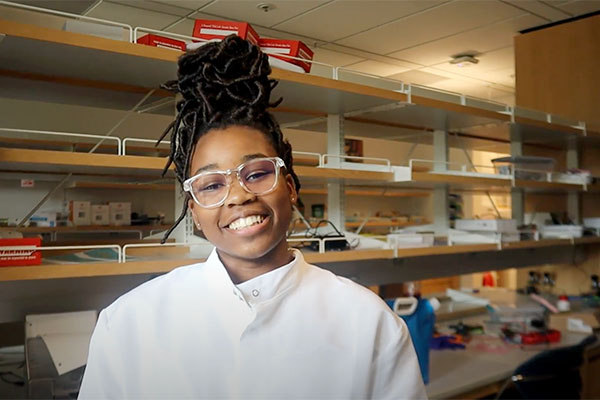O’Brien lab mentors local high school researcher
Christine O’Brien partnered with Black Girls Do STEM to host a high school student in her lab as part of an effort to introduce more girls to science and engineering

When Christine O’Brien, assistant professor of biomedical engineering, met Cynthia Chapple, founder of Black Girls Do STEM, it was obvious they had great potential for collaboration. They’re both researchers who are passionate about science as well as mentoring girls in STEM.
“It is so incredibly important that women, especially black and brown women, are in roles where they can champion and solve problems that affect them,” O’Brien said. “Girls are more likely to fall out of the STEM pipeline. It’s important to establish support structures and show them there’s a future for them in this space.”
Black Girls Do STEM is a St. Louis-based nonprofit that serves as one of those support structures. In the fall of 2022, O’Brien worked with Chapple to host 30 Black Girls Do STEM participants on a tour of the Center for Women’s Health Engineering at the McKelvey School of Engineering.
“The focus was on getting the girls to the center because that’s what resonates with our students,” Chapple said. “Many didn’t know they could research women’s health without becoming OB-GYNs.”
However, both O’Brien and Chapple agreed they wanted to do more.
“We wanted something that would offer more than exposure,” O’Brien said. “We wanted to build students’ resumes as well as their confidence and create tangible results that would allow them to see themselves as scientists or engineers.”
That’s what led to Laura Brown, a rising senior at Collegiate School of Medicine and Bioscience, a magnet high school in St. Louis, spending six weeks in O’Brien’s lab as a high school researcher.
“I love science and engineering because it challenges me to think and problem solve,” Brown said. “I hope to become a cardiothoracic surgeon when I’m older, and since this experience, I’ve considered majoring in biomedical engineering. Combining medicine and engineering is a great way to get into the field, which is developing new technologies every day.”
Much of Brown’s time was spent designing a system that will test the limits of a wearable device that monitors postpartum patients for excessive hemorrhaging. Earlier this year, the O’Brien lab won a prize from the National Institutes of Health’s Rapid Acceleration of Diagnostics Technology (RADx Tech) for Maternal Health Challenge to support further development of the device.
“Laura was exceptional,” O’Brien said. “I was surprised by how much she knew and how quickly she grasped new things. It was fun to see her reaction to things that we consider basic lab procedures, like using a syringe pump or 3D printer.”
“I really loved 3D printing,” Brown said. “Every week I made various shapes and figures for the different projects toward the study. It was cool to have an idea, make it on the computer and then have it in my hands a few hours later.”
Brown said the experience boosted her self-confidence, both in and out of the lab.
“I learned to have more confidence in myself when it came to asking questions, applying knowledge and working with numbers,” she said. “The team I worked with always encouraged me to ask questions and come to my own conclusions.”
O’Brien and Chapple both said they could see the positive change in Brown, especially when it came to her math skills.
“She said she’d lost some of her confidence in math during the COVID-19 pandemic,” O’Brien said. “Everything we do in the lab is math. Laura and I had a conversation halfway through the summer and she shared how much her confidence had grown. Math was now a tool to help her solve problems. That was a big success.”
“No matter if she goes on to be a biomedical engineer or a cardiothoracic surgeon, she will walk in with a skill set and a confidence that says ‘I can learn, I can grow, I can contribute and I too have a place in this space,’” Chapple said.
Brown will continue to work five to 10 hours a week in the lab during the academic year. O’Brien said she also hopes to bring in more students to the lab through Black Girls Do STEM and the Young Scientist Program, offered through the Roy and Diana Vagelos Division of Biology & Biomedical Sciences at Washington University in St. Louis.
“Laura operated at an undergraduate level, and I was surprised by how quickly she could figure things out, which is a tribute to Black Girls Do STEM and her high school,” O’Brien said. “This was a wonderful mentoring experience for my team, and we hope to continue to build up that pipeline next year.




